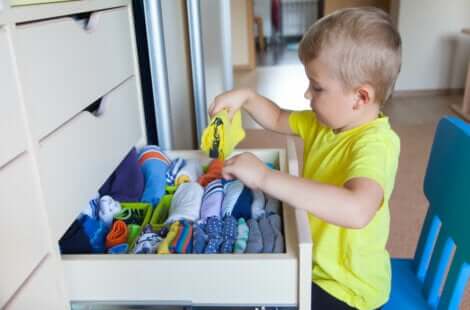Children's Independence Is Critical for Adult Success


Written and verified by the psychopedagogue María José Roldán
Protecting children or putting them inside an emotional bubble won’t help them grow up. A parent who doesn’t give them responsibilities and allow them to do basic tasks according to their age won’t be doing their children any favors. Children’s independence is critical to their adult success, and it depends on childhood responsibilities.
Learned helplessness
In fact, if children don’t have responsibilities, they can develop learned helplessness. Learned helplessness is when a child lacks independence and cannot or will not perform age-appropriate tasks. For your child to gain confidence and become more responsible, it’s important to promote children’s independence.
With learned helplessness, a child will think it’s not worth trying to do things on their own, because they won’t be able to do things well. They’ll end up thinking this way even though they have the capacity and tools to do things on their own.
Having been overprotected by parents or because others have always done things for them before, insecurity and low self-esteem undermine their real ability to get things done.
Tips to increase children’s independence
If you want your child to be successful in their adult life, it’s your job to enhance and increase their independence. Your child needs to realize that they are absolutely capable of doing the things they have skills for. Also, anything is possible with good teaching. In their upbringing, you can teach them how to do things on their own, and increase their independence and confidence. Don’t miss these tips!
Make a list
Create a list of chores that your child can do on their own, like getting dressed or putting away toys. Talk to your child about what you think they can do. If they aren’t sure, tell them to do it in front of you to see if they’re capable or if they need a little help. Eliminate tasks they’re not ready for. Children will do better when they know what is expected of them.
Don’t expect perfection
Don’t expect perfection with your child’s tasks. Children are still discovering their motor skills, so they might make mistakes. For example, they might spill some juice on themselves when they want to pour themselves a drink.
If they mess up, don’t criticize them or get angry, since this will only make them feel insecure. Instead, teach them the right way to do things. Tell them that we all make mistakes and no one is perfect.
Allow enough time
Children tend to need more time to complete tasks compared to adults. Give them the time they need to avoid stress. For example, if it takes your child ten minutes to put on their clothes in the morning, start their daily routine earlier. As they practice, they’ll become faster at their tasks.
Develop a routine for children’s independence
Children need routines to control their responsibilities and work on children’s independence. If their daily schedule is constantly changing, they’ll get confused. Explain when they need to complete specific tasks. For example, you can tell your child to pick up their toys before getting ready for bed. As bedtime approaches, remind your child to brush their teeth before putting their pajamas on.

Offer praise
Children love to be recognized for the things they do. Praise your child when they do something on their own, especially if it’s something they needed help with before. Also, you can even turn mistakes into praise. For example, if your child wears their shirt backwards, you may recognize that they were able to choose clothes and dress themselves.
Sense of responsibility and achievement for children’s independence
Encourage your child when they’re frustrated. It may seem easier and faster to do things for your children rather than allowing them to do it themselves. However, when you give children the opportunity to do tasks on their own, they start to develop a sense of accomplishment and responsibility.
As they get older, they’ll be able to use their own problem-solving skills to tackle new situations with ease. Promoting children’s independence and responsibility results in a person who is confident, resourceful, respectful and able to recognize and meet needs.
Protecting children or putting them inside an emotional bubble won’t help them grow up. A parent who doesn’t give them responsibilities and allow them to do basic tasks according to their age won’t be doing their children any favors. Children’s independence is critical to their adult success, and it depends on childhood responsibilities.
Learned helplessness
In fact, if children don’t have responsibilities, they can develop learned helplessness. Learned helplessness is when a child lacks independence and cannot or will not perform age-appropriate tasks. For your child to gain confidence and become more responsible, it’s important to promote children’s independence.
With learned helplessness, a child will think it’s not worth trying to do things on their own, because they won’t be able to do things well. They’ll end up thinking this way even though they have the capacity and tools to do things on their own.
Having been overprotected by parents or because others have always done things for them before, insecurity and low self-esteem undermine their real ability to get things done.
Tips to increase children’s independence
If you want your child to be successful in their adult life, it’s your job to enhance and increase their independence. Your child needs to realize that they are absolutely capable of doing the things they have skills for. Also, anything is possible with good teaching. In their upbringing, you can teach them how to do things on their own, and increase their independence and confidence. Don’t miss these tips!
Make a list
Create a list of chores that your child can do on their own, like getting dressed or putting away toys. Talk to your child about what you think they can do. If they aren’t sure, tell them to do it in front of you to see if they’re capable or if they need a little help. Eliminate tasks they’re not ready for. Children will do better when they know what is expected of them.
Don’t expect perfection
Don’t expect perfection with your child’s tasks. Children are still discovering their motor skills, so they might make mistakes. For example, they might spill some juice on themselves when they want to pour themselves a drink.
If they mess up, don’t criticize them or get angry, since this will only make them feel insecure. Instead, teach them the right way to do things. Tell them that we all make mistakes and no one is perfect.
Allow enough time
Children tend to need more time to complete tasks compared to adults. Give them the time they need to avoid stress. For example, if it takes your child ten minutes to put on their clothes in the morning, start their daily routine earlier. As they practice, they’ll become faster at their tasks.
Develop a routine for children’s independence
Children need routines to control their responsibilities and work on children’s independence. If their daily schedule is constantly changing, they’ll get confused. Explain when they need to complete specific tasks. For example, you can tell your child to pick up their toys before getting ready for bed. As bedtime approaches, remind your child to brush their teeth before putting their pajamas on.

Offer praise
Children love to be recognized for the things they do. Praise your child when they do something on their own, especially if it’s something they needed help with before. Also, you can even turn mistakes into praise. For example, if your child wears their shirt backwards, you may recognize that they were able to choose clothes and dress themselves.
Sense of responsibility and achievement for children’s independence
Encourage your child when they’re frustrated. It may seem easier and faster to do things for your children rather than allowing them to do it themselves. However, when you give children the opportunity to do tasks on their own, they start to develop a sense of accomplishment and responsibility.
As they get older, they’ll be able to use their own problem-solving skills to tackle new situations with ease. Promoting children’s independence and responsibility results in a person who is confident, resourceful, respectful and able to recognize and meet needs.
All cited sources were thoroughly reviewed by our team to ensure their quality, reliability, currency, and validity. The bibliography of this article was considered reliable and of academic or scientific accuracy.
- Cando Yaguar, M. E., & Campaña Toapanta, L. D. R. (2017). La sobreprotección infantil (Bachelor’s thesis, Latacunga: Universidad Técnica de Cotopaxi; Facultad de Ciencias Humanas y Educación; Licenciatura en Educación Básica). http://repositorio.utc.edu.ec/handle/27000/4316
- Cerino, A. (2023). The importance of recognising and promoting independence in young children: the role of the environment and the Danish forest school approach. Education, 51(4), 685-694.
- Edwards, M., Moya, C., Fabio, C., & Morales, F. (2015). Tiempo de Crecer, El desarrollo de los niños de 4 a 10 años. Santiago de Chile: Fondo de las Naciones Unidas para la Infancia, UNICEF, Andros Impresores. https://biblioteca.unicef.cl/es/tiempo-de-crecer-guia-para-la-familia-el-desarrollo-de-ninos-y-ninas-de-4-10-anos#:~:text=ISBN%3A%20978-92-806-4549-1%20En%20esta%20Gu%C3%ADa%20entrega%20herramientas%20para,oportunidades%20que%20necesitan%20para%20crecer%20y%20desarrollarse%20plenamente.
- Elguera, M. (2019). Fomentar la autoestima en el niño para un buen desarrollo socio emocional. Educación, 25(1), 63–66. https://revistas.unife.edu.pe/index.php/educacion/article/view/1770
- Pediatric Patient Education. (2021). Growing Independence: Tips for Parents of Young Children. American Academy of Pediatrics. Consultado el 31 de agosto de 2023. https://publications.aap.org/patiented/article/doi/10.1542/peo_document354/82011/Growing-IndependenceTips-for-Parents-of-Young?autologincheck=redirected
- Levine, A., & Philips, L. (8 de febrero de 2022). How to Build Independence in Preschoolers. Child Mind Institute. Consultado el 31 de agosto de 2023. https://childmind.org/article/how-to-build-independence-in-preschoolers/
This text is provided for informational purposes only and does not replace consultation with a professional. If in doubt, consult your specialist.








